
| HISTORY |
Hasegawa 1/48 Saab J35Ö Draken
| KIT #: | 09888 |
| PRICE: | £24.96 on sale |
| DECALS: | One option |
| REVIEWER: | Nicolai Plesberg |
| NOTES: | Pilot from Hasegawa’s US pilot / ground crew set B added to complete this flying mode build. Also added pitot probe set from Fine Molds. |

| HISTORY |
The history of the Austrian Draken acquisition dates back to the mid 60s when the Austrian defense began the studies of a replacement of the Saab J29F Tunnan then in service. As it was at that time four candidates were being studied: Northrop F-5A Freedom Fighter, Dassault Mirage IIIE, Douglas A-4F Skyhawk and Saab Draken. The resulting recommendation from the Luftraumsverteidigungskommision (the Austrian Air Defense Commission) sounded on the acquisition of 24 Saab Draken. Due to financial reasons it was instead decided to increase an order of 20 Saab 105Ö to 40, even though the Saab 105 was in no position to act as an air defense fighter.
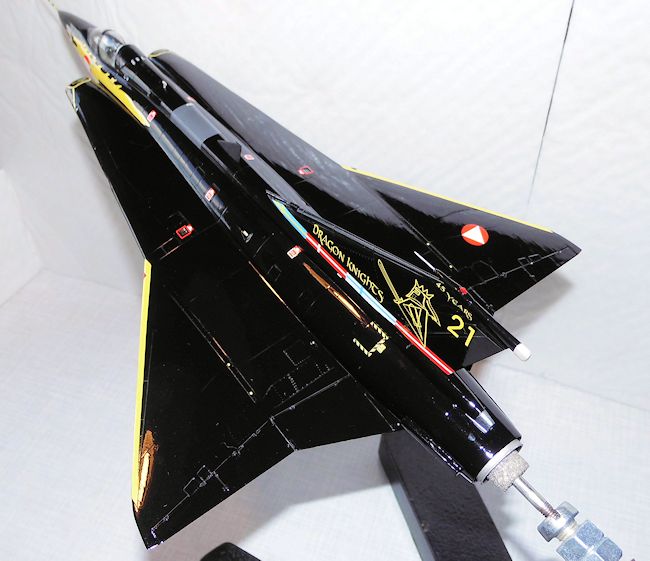 Up through the 1970s several studies
resulted in the almost acquisition of both the IAI Kfir and the Dassault
Mirage F-1, but various obstacles came in the way. In the summer of 1982 a
new study round began with a smaller ambitious goal as 24 used supersonic
aircraft were being sought. Once again Saab came along with the Draken, BAC
came with an offer of refurbished ex-Saudi Lightning F.Mk.53s, Northrop
offered factory new F-5E/F Tiger IIs and Dassault came once again along with
the Mirage IIIE. In the end Saab won the contract of delivering of 24
refurbished J35Ds together with a simulator, spare parts, ground equipment
as well as training of ground crew and pilots. A J35D airframe for
instructional purposes was also included.
Up through the 1970s several studies
resulted in the almost acquisition of both the IAI Kfir and the Dassault
Mirage F-1, but various obstacles came in the way. In the summer of 1982 a
new study round began with a smaller ambitious goal as 24 used supersonic
aircraft were being sought. Once again Saab came along with the Draken, BAC
came with an offer of refurbished ex-Saudi Lightning F.Mk.53s, Northrop
offered factory new F-5E/F Tiger IIs and Dassault came once again along with
the Mirage IIIE. In the end Saab won the contract of delivering of 24
refurbished J35Ds together with a simulator, spare parts, ground equipment
as well as training of ground crew and pilots. A J35D airframe for
instructional purposes was also included.
The 24 J35Ds were bought back from the Swedish Air Force and refurbished. Furthermore some instruments in the cockpit were replaced and modifications done to the radar and radio equipment all due to Austrian specifications. The only external alteration (apart from antennas), was, that the original D-style canopy was replaced with the one from the J35F. The modifications warranted that new Buzz-Numbers were given to the airframes and the designation changed to J35Ö (Ö for Österreich – Austria). The first J35Ö was delivered on June 25 1987 and the last one on May 18 1989. They entered service at the Austrian Army’s 2nd Fliegerregiment (Austria don’t have a separate air force – it is part of the army) split equally between the 1st and 2nd Staffel based respectively at Zeltweg and Thalerhof / Graz and tasked with the primary role of air defense.
During the early 1990s, when neighbouring Yugoslavia
broke apart into civil war, patrols were increased along the Austrian /
Yugoslav border. However, on several occasions armed Yugoslav fighters
violated Austrian
airspace. One of these violations of a Yugoslav MiG-21 reached as far as
Graz, which lies about 50 km inside
Austria. This resulted in a nationwide outcry and a nationwide debate on
what to do. The real problem was that the cannon-armed Austrian Drakens were
up against (mostly) missile armed MiG-21s, which in a dogfight have a great
advantage above cannon-armed opponents due to the longer range of missiles
instead of bullets, but the Austrian State Treaty from 1955, as imposed on
Austria by the victor powers from the Second World War, stated that Austrian
planes were forbidden to ever carry air to air missiles. However, after a
national debate the Austrian parliament voted to amend this regulation. This
opened up for that Austria could arm its aircraft with air to air missiles
and Sweden was again selected to
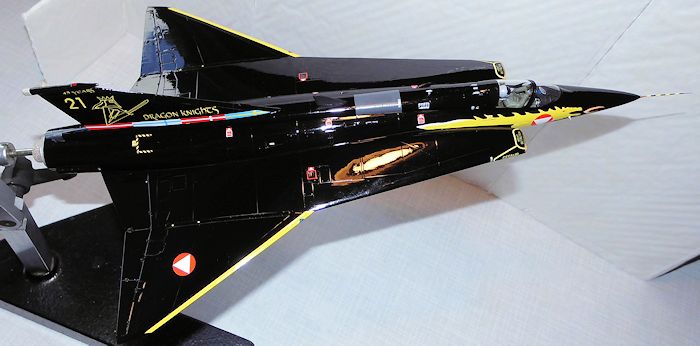 supply the hardware in form of the Rb24
Sidewinder, but later a higher performing variant was purchased directly
from the United States.
supply the hardware in form of the Rb24
Sidewinder, but later a higher performing variant was purchased directly
from the United States.
In the meantime at first, the Austrians tried to increase the aircrafts survival probability by installing a RWR system. However, they didn’t exactly have experience in installing such systems, so they contacted the Royal Danish Air Force and asked for assistance. The RDAF had for years flown their own Drakens with similar systems and so possessed the know-how. Furthermore the RDAF offered to install the MFCD (Modular Flare and Chaff Dispenser) system on the rear fuselages to add up to the upgrade of the Austrian Drakens, as they were in surplus; the reason being that the RDAF was in the process of phasing out their own Drakens at that time.
When in the mid 90s it was announced that the Swedish
Air Force was going to phase out their last Drakens before the end of the
decade, Saab announced that the manufacture of spare parts would end. This,
however, put the Austrians in a fix, as the contract stated that spare parts
would be available as long as the aircrafts were intended to be used.
However, in 1999 just after the Swedish service exit, the Austrians were
able to purchase 6 non airworthy J35Js for cannibalization; however this
proved to be a short lived tonic as the spares situation became rather
critical in the spring of 2001. So the Austrians were forced to do the
inevitable: phasing out the planes with the most logged flying hours and use
them as spare parts for the remaining planes. In 2002 the Drakens successor
had been selected in shape of the Eurofighter Typhoon. However, the first
Typhoon would not be available until 2007 and as a stopgap measure a deal
with neighbouring Switzerland secured a leasing agreement for the Austrians
to lease a number of Swiss F-5E/Fs. The Draken’s fate was hereby sealed and
toward the end of 2005 the remaining
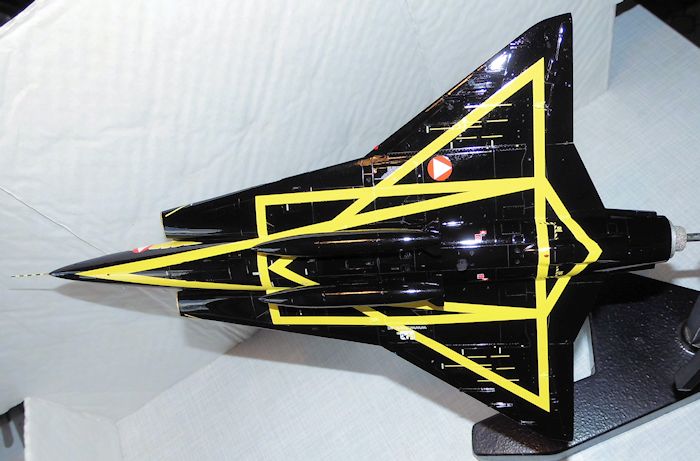 Drakens were phased out; the “21”
repainted in a striking all black retirement scheme as a tribute to the
“Dragon Knights” countries:
Drakens were phased out; the “21”
repainted in a striking all black retirement scheme as a tribute to the
“Dragon Knights” countries:
Sweden : 1960-1999
Denmark : 1970-1993
Finland : 1972-2000
Austria : 1987-2005
In all the Draken served 45 years in military service from its service entry in Sweden in 1960 to its final retirement in 2005 in Austria. The last flight took place on 22 December 2005 with Capt. Michael ‘KIM’ Kirchner at the controls.
| THE KIT |
This is just another boxing of Hasegawa’s already well known 1/48 Draken kit with all the parts and decals necessary to construct the specially painted Austrian Draken that had an entirely black painted airframe with a rather catchy scheme to mark the Drakens absolute final retirement from military service in 2005.
| CONSTRUCTION |
As this special scheme with all the
yellow line patterns on the undersides as decals and passing over the gear
bays and RAT bay, I decided to build this one in flight mode. This meant
that I would have to put a pilot in the cockpit to make it realistic. The
build went quite along the same lines as my other
builds,
builds,
builds,
builds
(pick one!) so I will just mention what was different here. The cockpit was
painted grey (Humbrol 64) as photos of Austrian Draken cockpits I found on
the web indicated some greyish color. As a pilot figure later should find
its way into the cockpit seatbelts were obviously unnecessary –
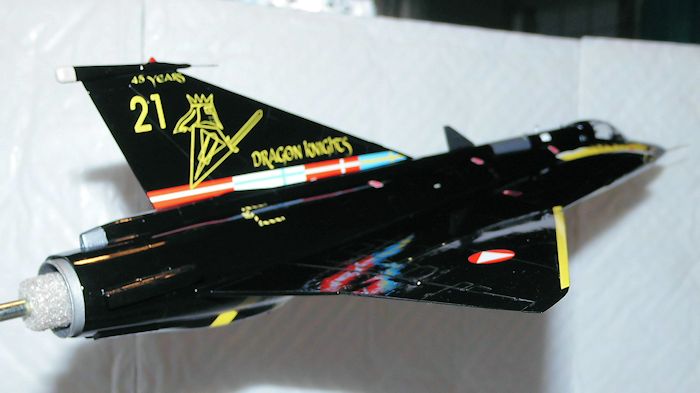 at least
until the pilot had been fixed in position, but more on that later!
at least
until the pilot had been fixed in position, but more on that later!
As the fuselage halves had been joined and seams taken care of I glued in the gear doors in closed position. Well actually there was little more to it than that so here goes; the nose gear doors needs a slight sanding on all four sides and in return the fit will be perfect – unless too much is sanded off! I recommend gluing one door in position; when the glue has set, fix the other door into position; in this way the positioning of the doors will be as intended.
The main gear doors were next. I started by gluing the inner doors plus the RAT bay door into position (no sanding necessary) and when set the outer doors were carefully attached. Some seam filling with the glue to strengthen the door assembly became necessary, but bear in mind: don’t do it to a perfect state as the rim of the doors should just be visible! The main gear doors fit almost as perfect as the nose gear doors, but the tail gear doors were a totally different matter! The front door lacks about 1 mm in length so a plastic bit should be added to fill the hole. The two rear doors needs to get their locating rim cut off and when attached, there is a gap between them of about 1mm so this should also be filled with a plastic bit. Here it is necessary to smooth things out with filler and sanding. Afterwards it’s necessary to scribe in a new separating line between the two rear doors.
After gluing outer wing sections, nose and rear fuselage and the fin to the fuselage, the airframe was just about complete. Only the pilot was missing so I could close up the cockpit and go to the paint shop. However, the search lasted much longer than I anticipated; the reason being that finding a suitable pilot wasn’t easy. As I almost two years after doing the last work on the airframe, I stumbled across Hasegawa’s Ground crew set B, which among others features six pilots in three different sitting positions. I used one where both arms were separate, but they were at the same time in a cramped way so it would require a lot of reshaping, but that was nothing compared to the legs!
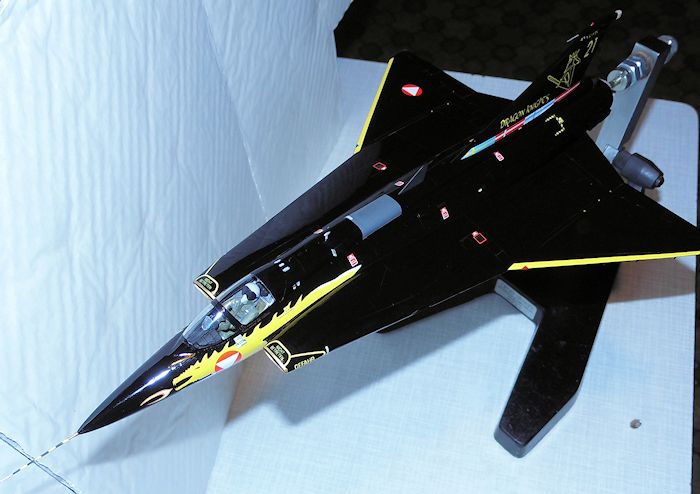 At first I cut off the legs below the
knees because they were too big to get through the recesses in the lower
edge of the instrument panel. Later I also discovered that I had to cut off
the legs at the hip and glue them into a new position. You see the ejection
seat in the Draken is a so-called inclined type so the plastic pilot’s
original 90 degree angle between body and legs should be increased, so it
would fit better into the seat. The holes arisen between the body and legs
were filled with plastic bits and filler; it took quite an effort to get
things in shape so the pilot could fit into the rather cramped cockpit.
At first I cut off the legs below the
knees because they were too big to get through the recesses in the lower
edge of the instrument panel. Later I also discovered that I had to cut off
the legs at the hip and glue them into a new position. You see the ejection
seat in the Draken is a so-called inclined type so the plastic pilot’s
original 90 degree angle between body and legs should be increased, so it
would fit better into the seat. The holes arisen between the body and legs
were filled with plastic bits and filler; it took quite an effort to get
things in shape so the pilot could fit into the rather cramped cockpit.
When the legs / body seams had been dealt with it was time to concentrate on the arms. They, too, had to be straightened out so the pilot could fit with the canopy closed. This was mostly done by heating with a candle (carefully!) cutting and inserting bits to fill out holes. When I deemed the arms finished they were glued to the body. As I discovered afterwards, when testing with the pilot in the cockpit, was to ensure that the left hand could securely be inside the perimeter of the windscreen, I had to cut it off and glue it on in a different angle; in return the fit including with the canopy / windscreen in place was now perfect. The last thing I did was to sand off the little knoll in front on the helmet, then making a new visor of Tamiya tape and attach it.
The suit was painted olive green (Humbrol 86) while helmet plus oxygen mask went grey (Humbrol 127). The oxygen hose plus gloves were painted green (Humbrol 116), suit harness grey (Humbrol 164) and buckles silver. The visor was painted satin black (Humbrol 85). It only took about two hours to paint the pilot, as I used the fast drying Humbrol Acrylic colors for the job. As soon as all paint had dried the pilot was secured to the seat with CA glue. I then took some thin strips of Tamiya tape and connected them from the shoulders to the seat so it looked as the pilot was “strapped” in. The seat belts were painted with the same grey color as the suit harness.
The next issue was to clean the clear bits then attach them to the cockpit rim. A few more parts were installed such as the wing fences before the entire airframe went through the usual cleaning process before going to the paint shop.
| COLORS & MARKINGS |
To make things easy I chose to paint the entire airframe gloss black (Humbrol 21) – three coats were necessary with a slight sanding after the first coat as I to my regret discovered small “turds” all over the airframe – why does this always happen? However, I devised a method to make sure that the paint dried protected against settling dust by putting a big plastic box reversed over it (with in-built ventilation holes) so the “turd” thing wouldn’t happen again. That was better! The next two coats were almost “turd” free.
 The edges of the intakes were painted
gold (Humbrol 16) as photos of the real plane taken at the museum at Zeltweg
(yes it has been preserved there together with the Draken that was painted
red / white to celebrate the 1000th
anniversary of Austria as a state) showed this. A bit of touch up of the
burned metal (Humbrol 53) the intakes were painted with became necessary but
after this the decals went on.
The edges of the intakes were painted
gold (Humbrol 16) as photos of the real plane taken at the museum at Zeltweg
(yes it has been preserved there together with the Draken that was painted
red / white to celebrate the 1000th
anniversary of Austria as a state) showed this. A bit of touch up of the
burned metal (Humbrol 53) the intakes were painted with became necessary but
after this the decals went on.
As I thoroughly had examined the decal sheet to determine which decals to put on first, I had come to the following order: First the yellow lines for the underside should be applied and then the dragonheads for the front fuselage should be applied. From there the rest could be applied as is.
Before I applied the first decal (no.3), I removed the little antenna below the windscreen (reattached post decaling) to make things easier. Decal no 3 (the forward part of the yellow arrow on the underside) was applied but unfortunately it “grabbed” almost immediately to the surface and got stuck. As more water didn’t seem to help I decided to remove it and start all over. In that process it took a bit of the paintwork with it! No wonder I couldn’t move it anywhere!
I touched the paint up with the fast
drying acrylic variant and then I grabbed the
spare sheet for the other kit which became
this.
I figured it would be a good idea to remove the superfluous carrier film
between the lines. I took a cutting mat, a steel ruler and secured a new tip
on my knife and with these to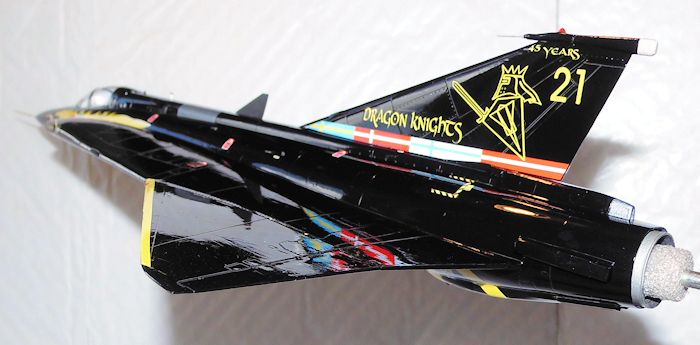 ols I succeeded to remove the carrier film as
intended. I then applied this decal and it went
much easier on! Of course
a different way of action could have been to cut the decal into more
handable pieces but that is a matter of taste. Anyway where the procedure
dictated it, I removed the superfluous carrier film so decal aligning could
be eased.
ols I succeeded to remove the carrier film as
intended. I then applied this decal and it went
much easier on! Of course
a different way of action could have been to cut the decal into more
handable pieces but that is a matter of taste. Anyway where the procedure
dictated it, I removed the superfluous carrier film so decal aligning could
be eased.
The rest of the decals went on with no further hassles. Upon completing decaling as things were, there were gaps here and there, so I found an almost exact match in the form of a lemon yellow color from Vallejo to touch up the gaps. Some other small discrepancies were touched up with gloss black and I also painted the pitot probe plus the AOA sensor in their respective colors. When all had dried thoroughly the whole airframe got a gloss coat to seal in everything.
I began the final leg of this build with gluing the intake for the avionics bay (part B1) with CA glue then I masked off the areas which would be painted in the remaining colors. As soon as they had been applied the masking tape was removed and the final bits attached.
| CONCLUSIONS |
I must say it was a great relief to get it finished after having lain idle for many months, but in the end it always pays off to get the right materials so the result will reflect ones efforts and expectations. And the Draken just deserves to get build in flight mode because it reveals its clean aesthetic lines better.
| REFERENCES |
I valued various photos of Austrian Drakens, particularly of the all black Dragon Knights Draken, that I found on www.airliners.net .
Copyright ModelingMadness.com October 2015
If you would like your product reviewed fairly and fairly quickly, please contact the editor or see other details in the Note to Contributors.